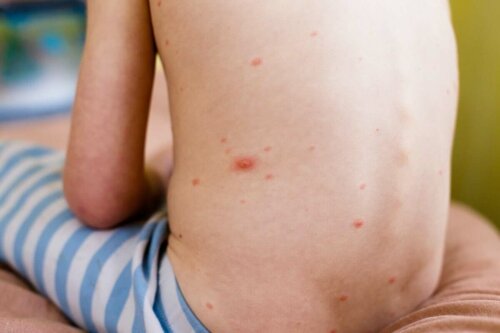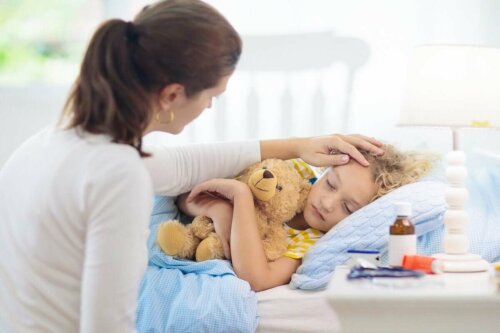How to Treat Hives in Children


Written and verified by the doctor Leonardo Biolatto
Most of the time, hives in children come as a result of an allergic skin reaction. In this case, it’s not the typical reddish bump in a specific area of the body but rather large lesions that are distributed over wide areas of the dermis.
Allergens are the substances that trigger allergic reactions and they’re variable for each individual. For example, a child can suffer from hives due to dust but perhaps their sibling doesn’t show any reaction to it.
Hives in children: the main symptoms
As previously mentioned, hives refer to a large allergic reaction that takes up large areas of skin. It appears shortly after coming into contact with irritating substances, which one can find in the environment, clothing, air, soil, and animal hair.
Now, pruritus is one of the main signs of hives. It’s an itch that’s so intense that it forces scratching and even carries the risk of injury. In this way, bacteria can enter there and reproduce, leading to a greater infection in the area.
Blisters and bumpy skin are noticeable, unlike in other milder allergic reactions. Swelling begins not many hours after exposure and is sometimes immediate (starts within a few minutes). This indicates a possible anaphylactic shock.
The size of the affected region varies from child to child. There may even be several body regions with active lesions at the same time. It’s common on the face, hands, feet, and groin. The torso isn’t exempt, especially in food allergies.
There are other associated symptoms apart from skin issues. Let’s see what they are.
- Vomiting and nausea. It comes from the same internal allergic process, which leads to inflammation of the gastric mucosa.
- Abdominal pain. Sometimes it comes up along with a mild fever. Other times, however, it’s due to the increase in intestinal peristalsis that tries to remove the allergens that went into the digestive tract.

Read also: Sulfites in Food – Allergies and Sensitivity
Common causes of allergy in pediatrics
Hives in children have many different causes. The point of origin is, as previously mentioned, being in contact with an allergic substance. However, there’s individual variability, which means all children react differently to different allergens. Most children are allergic to something specific. Here are some of the most common causes of allergy:
- Food. Some children are allergic to red fruits, others to eggs, and others to certain condiments and dressings. In general, parents discover the allergy when the first hives occur after consuming the allergen.
- Insects. Insect bites are a possible source of allergic reactions. In these cases, the affected area becomes excessively inflamed and it often spreads to other regions as well.
- Pollen from the environment. In seasonal allergies, the fall and spring months are the worst for children. In addition to the skin reaction, they often have coughing, sneezing, tearing, and even bronchospasm.
- Infections. In addition to the symptoms that come from the allergen, there are lesions due to a cross-reaction between the immune system and the cells of the human body. Both viruses and bacteria are to blame for the reaction.
- Medications. Many children have allergies to certain drugs. It’s important to be well-aware of what the children are taking. Most leaflets contain information and warnings in this regard since, many times, it’s not the active component that produces the allergy, but the excipients that chemists put in the pills or syrups to be able to market them.
- Perfumes. Cosmetics and perfumes can be powerful skin irritants, which is why there are lots of different brands of perfumes meant for children. However, if the child’s skin is too sensitive, odds are it’ll react anyway.
How to treat hives in children
First off, hives in children aren’t always easy to diagnose. Once that’s done, it’s important that the medical professional administers antiallergic drugs to counteract the symptoms. In the same way, the child can also make use of useful home remedies. This combination is great in order for the child to recover quicker.
Antihistamines are incredibly popular among allergy drugs. In fact, most people like to take diphenhydramine and loratadine in the case of allergies since they relieve itching and reduce skin redness.
Nonetheless, this isn’t the greatest option for children since they tend to make people drowsy. However, in extreme cases, they’re used with caution at minimal doses.
If the allergy is spread throughout many parts of the body, it may be necessary to add corticosteroids. It’s important to consult with a pediatrician since they’re the ones who will know if the case really entails it.
When used for a limited time, there should be no long-term problems. Intramuscular or intravenous use is exclusive to hives that develop into anaphylactic shock (which is rare).
Home remedies
As for home remedies, there are many different options. Believe it or not, there are several ingredients that can be used to make compresses that relieve local symptoms, especially itching.
The easiest way to relieve allergy symptoms is by using cold cloths. The low temperature decreases inflammation and redness which, in turn, diminishes the allergic reaction. Using them along with antihistamines and corticosteroids provides significant relief.
As prevention, it’s important for the child to avoid all those allergens they react to. Also, it’s vital to condition the bedroom of a child who suffers from allergies. Therefore, their room mustn’t have carpets or fabrics that accumulate mites easily. Adding a dehumidifier is also a good idea to reduce ambient dust.
Now, in the case where the child develops hives because of food, simply remove the allergen in question from their diet. For infants up to 2 years, there are substances (such as strawberries) that they shouldn’t consume as a precaution since they can be powerful allergy generators for some.

Read also: 5 natural remedies to relieve itching
Always consult a pediatrician
This is the most important advice here. Hives in children don’t go away from one day to the next. For that reason, it’s vital to consult a pediatrician. Remember that a professional approach is essential in order to know the causes and reduce the symptoms of a particular case.
If allergies happen repeatedly, be very careful about the possibility of anaphylactic shock. This constitutes an emergency situation that often requires hospitalization, and you should do everything you can to prevent this.
All cited sources were thoroughly reviewed by our team to ensure their quality, reliability, currency, and validity. The bibliography of this article was considered reliable and of academic or scientific accuracy.
- Máspero, Jorge, et al. “GUÍA ARGENTINA DE URTICARIA Y ANGIOEDEMA.” Medicina (Buenos Aires) 74 (2014).
- Talamantes, Concepción Sierra, Violeta Zaragozá Ninet, and Remedios Alamar Martínez. “Aproximación a la clínica: diagnóstico y manejo de la urticaria.” Enfermería Dermatológica 11.32 (2017): 10-23.
- Zúñiga, Roberto Velasco. “PROTOCOLOS DIAGNÓSTICOS Y TERAPÉUTICOS EN URGENCIAS DE PEDIATRÍA.” (2019).
- Hung, Lisa, et al. “Human ex vivo and in vitro disease models to study food allergy.” Asia Pacific Allergy 9.1 (2018).
- Casanueva, C. Ortega. “Alergia a la picadura de insectos.” PediatríaIntegral (2018): 138.
- López, José Guadalupe Huerta, Álvaro Pedroza Meléndez, and Enrique López Valentín. “Urticaria crónica en niños. Revisión sistemática.” Alergia, Asma e Inmunología Pediátricas 29.1 (2020): 16-30.
- de Miguel, Cristina Salas. “Urticaria, anafilaxia e intoxicación en pediatría.” (2018).
- de Durana, María Dolores Alonso Díaz. Alergia a los pólenes de ciprés y olivo: fenotipos clínicos y perfil de reconocimiento de alérgenos en pacientes con doble sensibilización. Diss. Universidad de Alcalá, 2017.
- Ferreira, Margarida Silva Vicente. Alergia de contacto a perfumes: 5 anos de experiência de consulta. MS thesis. 2016.
This text is provided for informational purposes only and does not replace consultation with a professional. If in doubt, consult your specialist.








